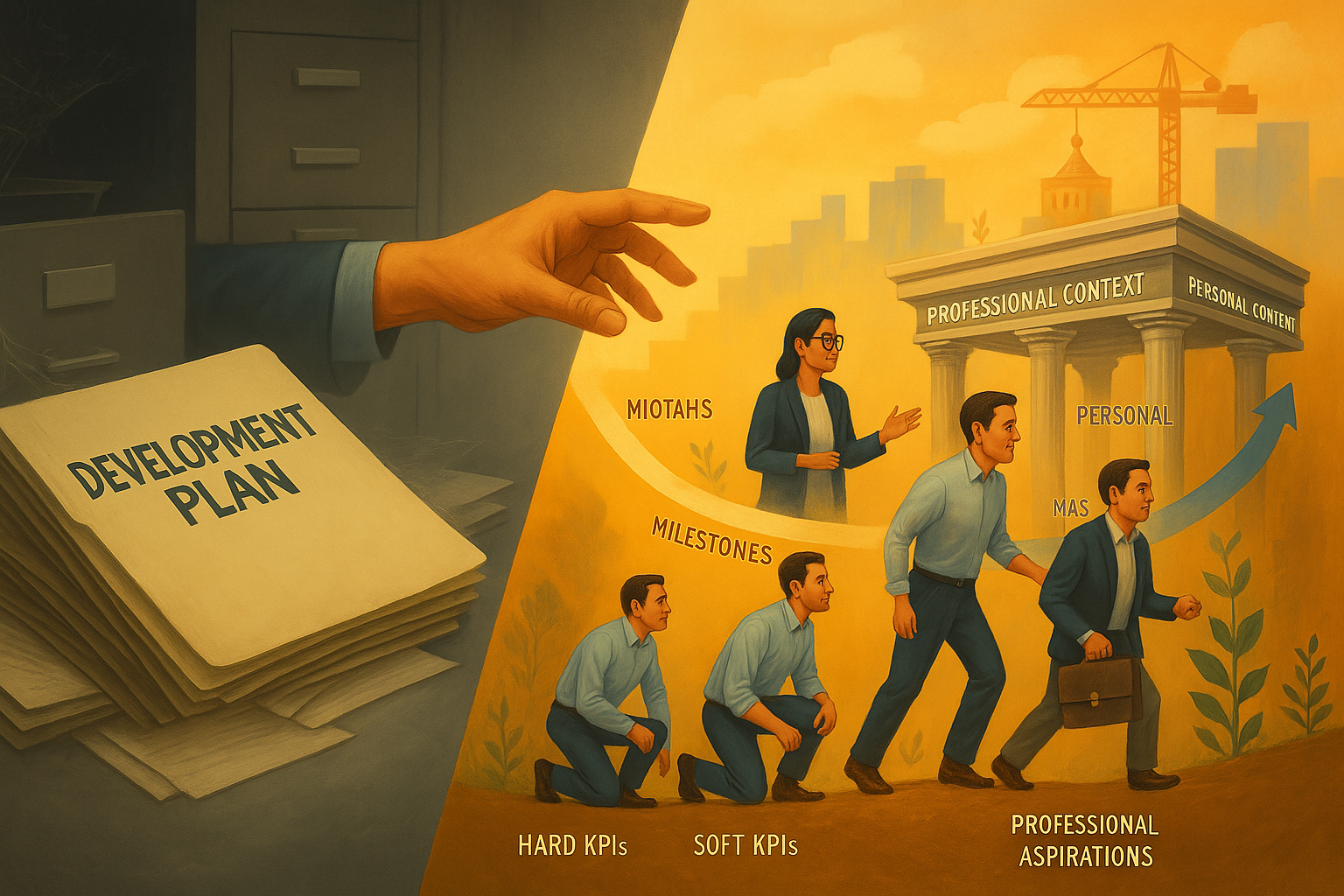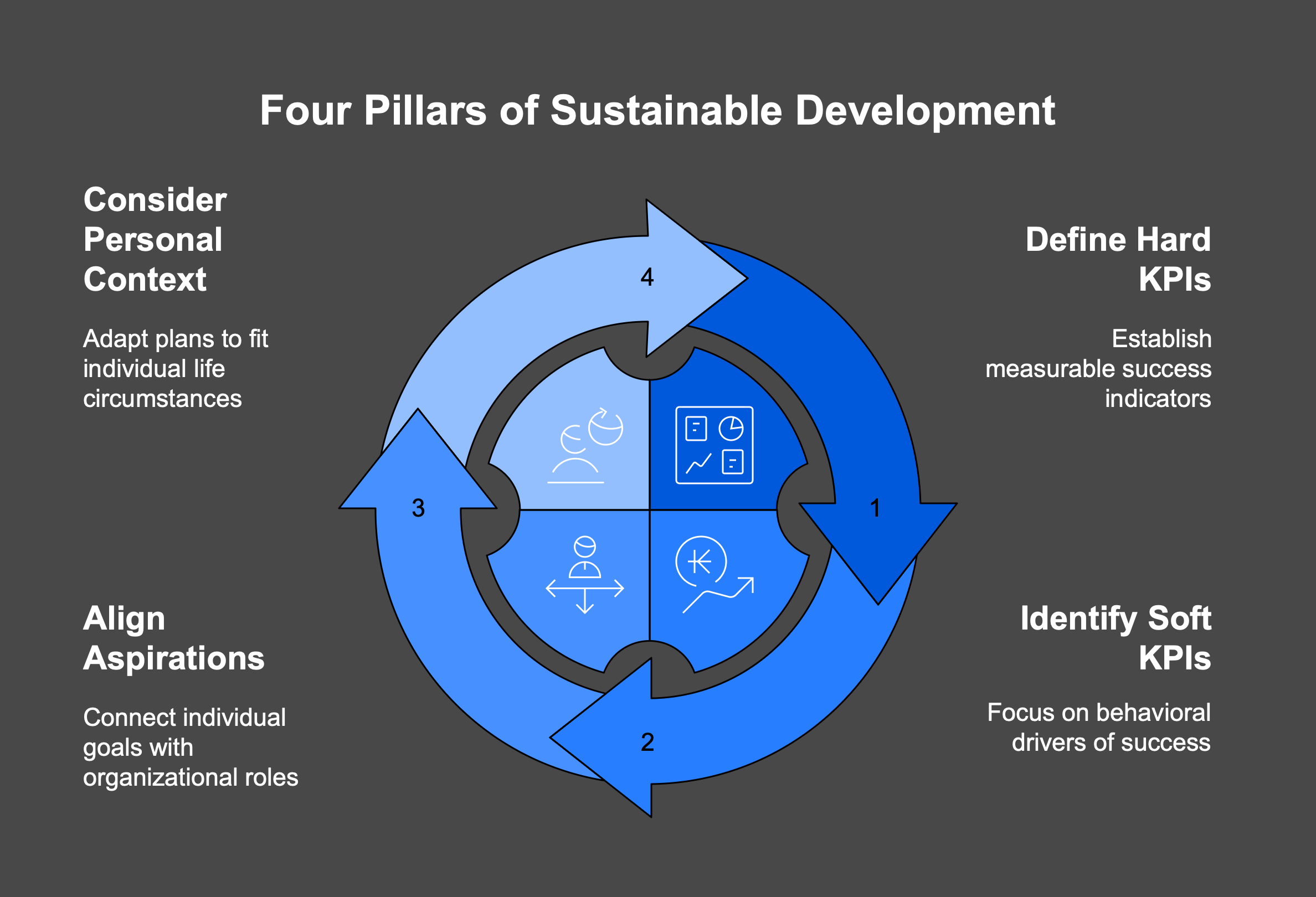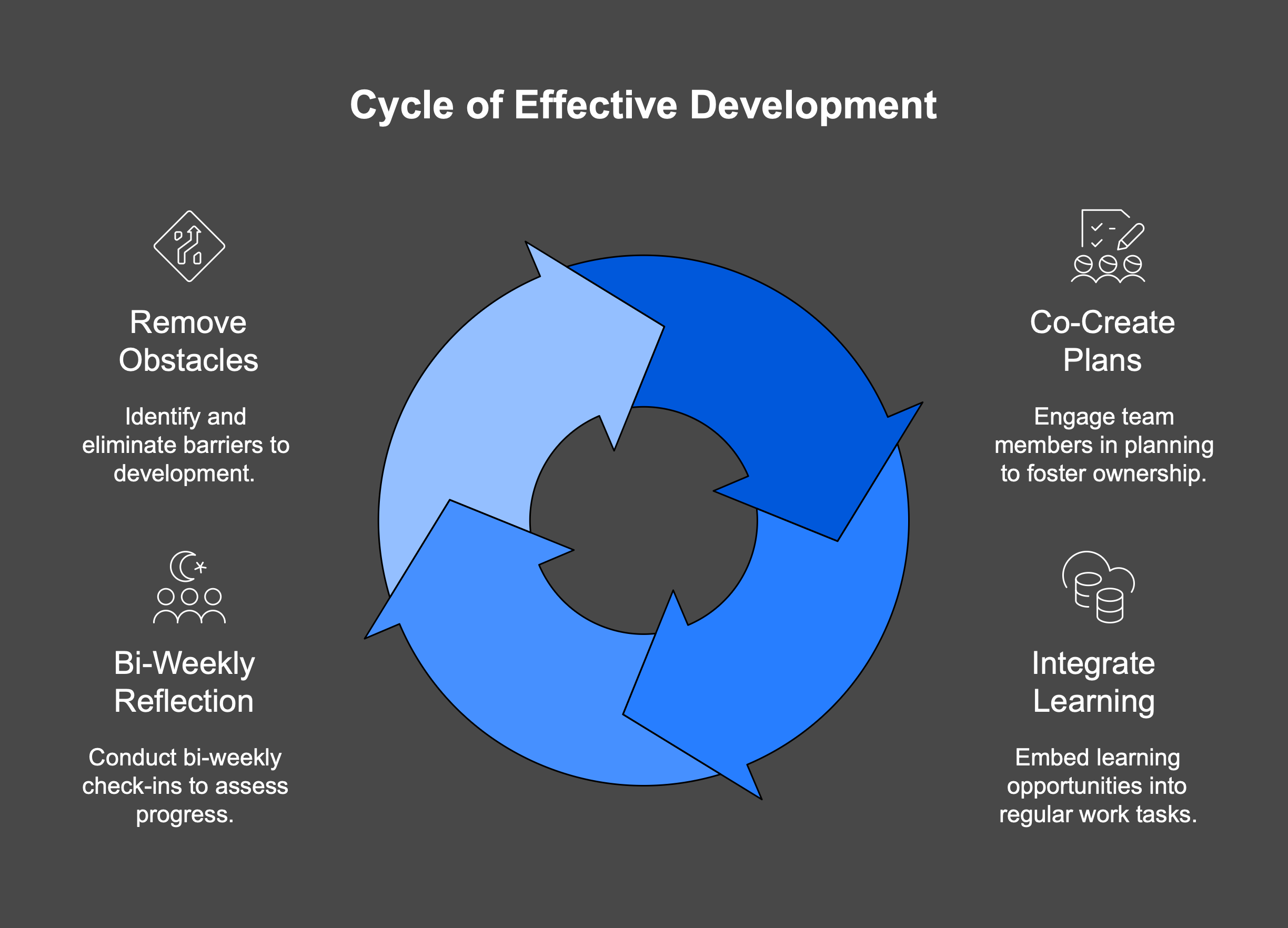The Intensity Method Part III: Personal Development Plans That Actually Develop People
Transform workplace potential in a three-step journey (assessment, evaluation, development); Part III focuses on crafting personal development plans that genuinely foster growth.

Let’s get real: most personal development plans are performative nonsense. They’re scribbled during annual review season, shoved into an HR portal, and forgotten faster than your gym membership by February. They’re built to check boxes, not change lives.
After leading teams through startups, enterprises, and everything in between, I’ve seen enough abandoned plans to wallpaper every WeWork on the planet. The issue isn’t the concept of development. It’s the execution. Most plans lack soul, specificity, or follow-through. Here’s how to craft personal development plans that move the needle, spark growth, and respect the human behind the job title.
The Commitment Contract That Rewrites Futures
A development plan isn’t a form. It’s a commitment contract between someone and their future self, with you as the coach, witness, and occasional nudge. Done right, it transforms vague dreams like “get better at leadership” into clear, actionable paths with milestones that matter. It balances professional ambition with personal realities, born from honest reflection, not corporate pressure to “look productive.”
I once worked with a brilliant product manager who was dropping the ball on cross-functional communication. A generic plan would’ve slapped him with “improve stakeholder management skills” and called it a day. Useless. Instead, we dug deeper. We identified which relationships were fraying (engineering leads, mostly), what habits were causing friction (over-emailing instead of face-to-face chats), and which skills would close the gap (active listening, concise pitching). We leaned into his strengths—killer 1:1 conversations—and built practice for his weak spots, like presenting to big groups, right into his daily work.
Six months later, he was running executive reviews like a pro, not because of some HR template, but because we turned a commitment into a living process. That’s the magic: a plan that’s less about paperwork and more about rewiring how someone shows up every day.
Four Pillars for Development That Sticks
Over decades of trial and error, I’ve distilled effective development plans into four dimensions. Miss one, and the whole thing collapses like a bad startup pitch.
- Hard KPIs: The Measurable Backbone
These are the numbers that scream success: revenue for sales, story points for engineers, retention rates for customer success. They answer the blunt question, “Are you delivering?” But numbers are just the scoreboard. Focusing only on them is like treating a fever with a thermometer. They show what’s happening, not why or how. - Soft KPIs: The Behavioral Engine
These are the skills, habits, and mindsets that drive those numbers—stuff like conflict resolution, adaptability, or strategic thinking. They’re harder to quantify but often the real lever for growth. For my product manager, hard KPIs flagged missed deadlines. Soft KPIs revealed the root: he avoided tough conversations, letting requirements creep and scope bloat. Coaching him to tackle conflict head-on fixed the metrics. Numbers were the symptom; behaviors were the cure. - Professional Aspirations: The Long Game
People aren’t static assets to optimize. They’re professionals with dreams, not just cogs in your org chart. Effective development plans look beyond today’s role to where someone wants to go tomorrow. I once had a skilled solution consultant who was itching to step into leadership. The real question wasn’t just his ambition—it was whether he was ready to lead without tripping over his own ego. I worked closely with him to ensure his message didn’t just echo in the room but actually landed with the team. Nothing tanks a leader faster than folks nodding politely while ignoring you behind your back. We focused on tackling pain points without pointing fingers, clarifying roles and responsibilities, and sparring with the team collaboratively instead of strutting in with an “I know everything” vibe. That work paid off—he stayed sharp in his current role, earned real trust, and eventually stepped into leadership with a team that followed because they wanted to, not because they had to. Aligning plans with aspirations isn’t charity—it’s enlightened self-interest. People shine when they see today’s grind as a path to tomorrow’s vision. - Personal Context: The Human Factor
Life doesn’t clock out at 5 p.m. A new parent, a family crisis, a cross-country move—these shape what someone can bring to work. Ignore them, and you’re setting people up to fail. I once supported a solution engineer who needed a break from his office hours during his mom’s illness. We shifted his work schedule to focus on documentation and knowledge sharing (remote work)—valuable work that fits his bandwidth. When life stabilized, he came back stronger, with deeper institutional knowledge and zero career penalty. Development plans must flex to fit the whole person, not just the employee.

Turning Plans Into Action That Delivers
A plan without action is just a daydream. Here’s how to make development real, not theoretical:
- Co-Create, Don’t Dictate: The most powerful question is, “What do you think?” When people shape their own plans, they’re already halfway to owning them. I ask team members to draft theirs after we align on their strengths and gaps. It’s not about ceding control—it’s about sparking commitment from day one.
- Weave Into Work: Development shouldn’t mean extra homework. If someone needs better presentations, let them practice in team meetings with pointed feedback. Need strategic thinking? Pull them into planning sessions they’d usually miss. I once had a shy designer who needed confidence in client pitches. We gave her low-stakes intros to lead, building up to bigger moments. Learning that’s part of the job sticks; workshops alone fade.
- Reflect Often: Quarterly reviews are too slow, and daily check-ins are too much. Bi-weekly chats hit the sweet spot. Keep it simple: What’s working? What’s tough? What do you need? What did you learn? These conversations keep development alive, not buried in a drawer.
- Clear Obstacles: Your job as a leader is to remove roadblocks. If they need leadership exposure, get them in the room. Need a mentor? Make the connection. Need time? Reprioritize their load. This isn’t coddling—it’s investing in capability that pays dividends.

Accountability That Fuels Growth, Not Fear
Accountability isn’t about cracking the whip. It’s about “support without softness.” Create space for people to admit struggles without shame, but don’t let avoidance slide. When someone’s off track, lead with curiosity: “What’s getting in the way?” Not “Why didn’t you do this?” Often, it’s fixable—a clashing priority, a missing skill, or a tool they don’t have. Sometimes, it’s motivation, which needs a reset tied to purpose.
I once had a sales lead who stalled on her development goal to improve forecasting. Instead of lecturing, we unpacked it. Turns out, she felt overwhelmed by new CRM tools. We paired her with a tech-savvy peer for quick coaching, and she was back on track in weeks. Accountability with empathy gets results; blame just builds walls.
The Raw Truth Nobody Wants to Hear
Here’s the uncomfortable bit: not everyone wants to grow. Some folks are fine coasting, and that’s their call—until their performance doesn’t cut it. Then, development isn’t optional; it’s survival. My approach is radical candor: “Here’s the gap between where you are and what’s expected. Development’s the bridge. Want to build it together?” Most step up when the stakes are clear. Those who don’t often self-select out, which is healthier for everyone.
I saw this with a mid-level manager who resisted feedback on his team’s low morale. We laid out a plan to improve his emotional intelligence, with specific steps like active listening workshops and peer reviews. He opted out, left the company, and later thanked me for the clarity—it pushed him to find a better fit. Growth isn’t universal, but honesty should be.
Why This Matters More Than Ever
When you are drowning in AI hype and remote work noise, human growth isn’t just a buzzword—it’s the pulse of teams that thrive. This trilogy, The Intensity Method, rips through the corporate fog.
Part I, Assessment, yanked back the curtain, exposing real patterns over polished demos—because truth trumps theater. Part II, Evaluation, turned those patterns into predictions, cutting noise to map what’s possible. Now, Development Plans builds the bridge from insight to impact, crafting growth that sticks. Together, they’re a no-nonsense system to know yourself, measure what matters, and act with purpose.
Development isn’t a form you file—it’s a pact you live, fueling capability and connection. Want to own it? Check for my upcoming free Intensity Method Workbook or join my upcoming crash course at neurallyintense.com. This series is done, but I’m not—next up, "A Beginner’s Guide to AI, LLMs, NLP, and Machine Translation: Let’s Start at the Very Beginning." What’s your take?
Stay Raw | Stay Real | Stay Intense.
